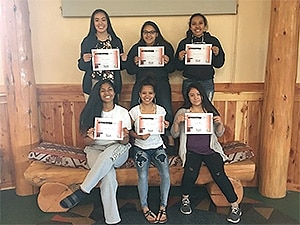STAND-ing with Native Communities
OREGON PREVENTION RESEARCH CENTER
Public Health Problem
Nearly 30% of Native American and Alaska Native high school students reported being sexually active in 2013.1 At that time, there were no culturally appropriate sexual health curriculums to support these youth.
PRC Response
During the 2014–2019 funding cycle, the Oregon Prevention Research Center (PRC) adapted a teen AIDS and early pregnancy prevention program called Students Together Against Negative Decisions (STAND) to make it relevant for young people living in Native American and Native Alaskan communities.
Researchers worked with tribal health leaders across the United States, Native youth groups, and subject matter experts from Indian Country to adapt the program. Native STAND uses a train-the-trainer model to teach youth about developing and maintaining healthy relationships and self-esteem, and preventing sexually transmitted diseases, early pregnancy, and substance use.
The Oregon PRC implemented the program in 48 communities across the country and awarded each community a 2-year grant to incentivize youth participation, implement program activities, and promote the program through visibility and word-of-mouth (see Figure 1).
Figure 1: Native STAND implementation process
Oregon PRC trained 48 tribal health educators via one-week workshops. Three cohorts were trained over three summers.

Tribal health educators trained teens ages 14-18 years from their communities to deliver the 27-lesson, peer-to-peer program.

Teens implemented the curriculum during afterschool and community activities, Boys and Girls Clubs meetings, and weekend retreats.
Accomplishments

By the end of the project in 2019, more than 900 young people were trained and delivered the Native STAND program to rural reservation and urban communities. The Oregon PRC systematically evaluated the effectiveness of the program.
Below are a few highlights (view the Native STAND full presentation):
- Tribal health educators learned how to better communicate and teach teens about sensitive health topics such as sexually transmitted infections, HIV and AIDS, drug and alcohol use, and healthy relationships. One Native STAND educator shared: “It’s just amazing, the conversations that these youth are having… They’re really not scared to talk about it. They just need a place to do it.”
- School staff and administrators felt Native STAND addressed gaps in tribal adolescent sexual health education. A Native STAND trainee mentioned: “I got feedback from a young man’s parents, and the dad indicated that [Native STAND] made it easier to talk to him about the different STDs and about relationships because of what we’ve been implementing.”
- Teens demonstrated significant and consistent improvements in their knowledge of sexually transmitted diseases and HIV prevention, reproductive health, and healthy relationships. Check out the full report of their findings.
- Teens reported feeling more confident about how to use a condom correctly.
- Female confidence increased from 37% to 55%.
- Male confidence increased from 45% to 60%.
- Trans/nonbinary confidence increased from 22% to 67%.
- Teens reported feeling more confident about their ability to get a condom.
- Female confidence increased from 39% to 50%.
- Male confidence increased from 49% to 61%.
- Trans/nonbinary confidence increased from 44% to 56%.
- More teens reported having conversations about sex with friends.
- Female conversations increased from 32% to 43%.
- Male conversations increased from 27% to 34%.
- Trans/nonbinary conversations increased from 44% to 50%.
- Teens reported feeling more confident about how to use a condom correctly.
After the project ended in 2019, Native STAND and its team explored moving the curriculum from an in-person model to an online training method. As of 2019, Native STAND is the largest health education program in native communities, delivered to 17 Western states. The possibility of reaching every community with the Native STAND program is on the horizon.
- Centers for Disease Control and Prevention. High School YRBS: United States 2013 Results. Available at Nccd.cdc.gov/Youthonline/App/Results.aspx. Accessed December 9, 2022.